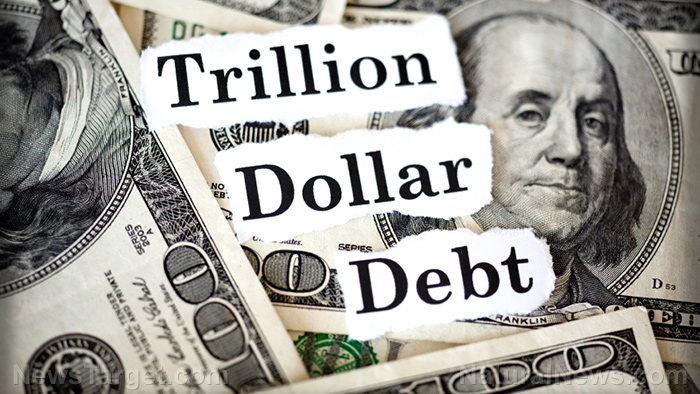U.S. national debt hits $33 trillion mark, with $1 trillion incurred in just the last 3 months
By oliviacook // 2023-09-21
Tweet
Share
Copy

The gross national debt of the U.S. surpassed $33 trillion on Sept. 18 – just three months after hitting the $32 trillion mark. The non-profit Committee for a Responsible Federal Budget (CRFB) said in a press release that on June 15, the federal government's gross debt eclipsed $32 trillion.
By comparison, the national debt was less than a trillion – $907 billion – four decades ago.
"After the debt ceiling showdown in June, we crossed the $32 trillion debt milestone. Now, as we stare down a potential government shutdown just three months later, we have raced past $33 trillion in red ink,"
Michael A. Peterson, CEO of the Peter G. Peterson Foundation (PGPF), said in a statement.
"The concern we have at the [PGPF] is not whether the national debt should ever be used. It should be how it is used and how much it is used. And unfortunately, we're using it for rainy days and sunny days right now."
Economists measure a nation’s debt severity based on its debt-to-GDP ratio. The U.S. debt held by the public is nearly at 100 percent, CNBC reported. According to the Committee for Economic Development of The Conference Board, a responsible ratio for a country the size of the U.S. would be 70 percent.
Peterson noted that lawmakers from both parties should work together to avoid a government shutdown and focus their efforts on stabilizing our national debt. "As we have seen with recent growth in inflation and interest rates, the cost of debt can mount suddenly and rapidly," he said. "With more than $10 trillion of interest costs over the next decade, this compounding fiscal cycle will only continue to do damage to our kids and grandkids."
The Congressional Budget Office confirmed that the underlying deficit is going to roughly double from last fiscal year to this one. While the Fiscal Responsibility Act of 2023 was a step in the right direction, getting the debt under control will require taking a serious look at health care, Social Security and the tax code.
If policymakers find it too difficult to do this under regular order, then they should put in place a bipartisan fiscal commission to propose solutions. They need to be straight with the American public and come together on a plan to bring national debt under control.
Major drivers of the growing U.S. national debt
America's growing debt is the result of simple math – each year, there is a mismatch between spending and revenues. (Related: DEBT BLOWOUT: US debt has soared $1.2T since debt ceiling suspension – and the Treasury expects to add another $1.5T by year’s end.) Today, deficits are caused mainly by predictable structural factors – the aging "baby-boomer" generation, rising healthcare costs and a tax system that does not have enough money to pay for what the government has promised its citizens, according to the PGPF.Aging demographics
America’s society is aging as the large ‘baby boomer’ generation (those born between the end of World War II in 1945 and the mid-1960s) begins to retire – with 10,000 turning 65 every day through 2030. This huge demographic trend puts increasing pressure on the federal budget. In particular, vital programs that serve older and vulnerable Americans –such as Social Security, Medicare and Medicaid – bear the heaviest brunt.Rising healthcare costs
The U.S. healthcare system, said to be the most expensive in the world, represents nearly one-fifth of the entire economy. It is also the second fastest-growing part of the budget. The country spends over twice as much on healthcare as other advanced nations. Experts say improving the performance of the U.S. healthcare system will not only improve Americans’ lives, but will also help stabilize the country’s fiscal and economic outlook.Inadequate revenues
The U.S. tax system does not generate enough revenue to cover the spending policymakers have enacted. According to the 2022 Federal Revenues and Spending report, total revenues were reported at $4.9 trillion as against total spending reported at $6.3 trillion. The PGPF says this rapidly growing imbalance between revenues and spending leads to higher and higher annual deficits, resulting in an increasing national debt balance. As the debt grows, so does the interest that needs to be paid and spending over $1.8 billion every day on interest will become the "fastest-growing part of the federal budget." In 10 years, the interest will more than double where it is today and “every dollar that goes toward interest payments means less resources available to build a stronger, more resilient future. Visit GovernmentDebt.news for more stories about America's debt that continues to grow. Watch Gregory Mannarino pointing out the skyrocketing U.S. debt as shown by the collapse of leading economic indicators. This video is from the What is Happening channel on Brighteon.com.More related stories:
US national debt will continue to rise in the coming years, says IMF. US, China heaviest borrowers in first quarter as global debt soars to #305 trillion. US national debt hits $31 TRILLION for the first time. Sources include: FoxBusiness.com CRFB.org PGPF.org 1 PGPF.org 2 Brighteon.comTweet
Share
Copy
Tagged Under:
economic collapse collapse taxes debt collapse national debt big government government spending risk budget deficit inflation pensions healthcare costs aging population government debt debt bomb tax revenue economic riot government borrowing
You Might Also Like
Russia has almost fully bypassed Western sanctions on its oil exports
By Cassie B. // Share
Target partners with Homeland Security in bid to curb surge in theft
By Richard Brown // Share
By News Editors // Share
Recent News
Canada's RCMP spent millions on Chinese drones now deemed "high security risks"
By bellecarter // Share
Creatine: The brain-boosting supplement you need after a sleepless night
By patricklewis // Share
How IRON powers the body and why this mineral matters
By avagrace // Share
Metabolic tune-up: How dietary restriction may supercharge cancer immunotherapy
By willowt // Share











